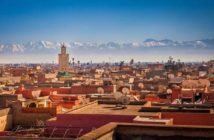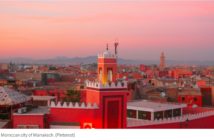
One cup of tea, you are a stranger. Second cup of tea, you are a friend. Third cup of tea, you become family,” goes the Balti proverb that inspired the title of the bookThree Cups of Tea by Greg Mortensen about Morocco. We had flown to Marrakech with no pre-trip preparation whatsoever apart from a Google Maps printout with sketch-pen notes scribbled across it, assured that Moroccan hospitality would take care of the rest.
It was -2 degrees Celsius on a winter morning when my husband and I made our plans to get out of London. Our criteria were clear—we wanted to get away to places with sunshine, street shopping and spicy food; all the things we missed in London. With most of Europe still snowed under, we looked south—and there Morocco was, suggesting itself.
******
A Berber cap stall
As soon as we reached Marrakech, we got out of ourriad (a traditional Moroccan house) and started our day with a tall glass of fresh orange juice in the town’s main square. We immediately entered into the labyrinth ofsouks (markets) through a nearby archway. Souks refer to the commercial quarters of any Arab city, specifically the weekly markets. These weekly markets began centuries ago when merchants in caravans would travel through towns displaying their goods. These days,souks typically consist of tiny stalls in crowded alleyways, displaying objects ranging from colourful scarves to buckets of olives. In most Arab cities, souksremain a network of interconnected markets selling a wildly diverse array of goods across a large space.
All our senses came under attack the moment we entered Marrakech’s souks. Bright colours, the incessant calls of hawkers, the smells of mint tea and meat were all around us. We walked deeper and deeper into the souks, and stopped to eat some lamb kebabs at a street stall. Nearby, a craftsman was making skewers out of wood. With his feet moving on a pedal that was connected to a carving knife, he deftly carved out handles of skewers. Noticing my interest, he quickly picked up a small piece of wood and pared out a pendant for me in no time.
******
A souk selling lanterns
The souks can seem never-ending. There appear to be no borders or boundaries. Walking through can be disorienting. Finding your way through the maze of shops is an art. In Marrakech’s souks, it’s easy to get lost, but also easy to get out—all you have to do is to ask for directions to the main square and find your way in all over again.
The passages between shops in Marrakech’s soukswere crowded, with tourists clicking pictures, locals on two-wheelers and donkeys carrying wares for stalls. At every turn in the passageway, we found ourselves in a new souk, named typically after what they were selling. Souk Semmarine (the textile market) was followed by Souk el Attarin (the spice and perfume market), which in turn was followed by Souk Cherratin (the leather-work market).
As we walked through the passages, we came upon Souk Zrabia, or the carpet market. This souk is famous for Berber carpets, popularly known as Berber Picasso (because they are often compared to expensive art). These are made from camel wool, sheep wool, even cactus silk. Simple designs woven on these fabrics tell stories about the nomadic life of the Berber tribe.
A tajine of chicken and olives is a street-food staple
The price of these carpets varies depending on the intricacy of the designs, the size of the carpet—and your nationality (foreign tourists often get singled out for higher price points). These carpets were traditionally made by the Berber tribes, but that is no longer the case; many Marrakech locals today pose as Berbers, wearing blue robes and traditional headgear.
We entered one of these shops, where the owner demonstrated to us the process of weaving designs on wool to make a carpet while his wife made us cups of mint tea. As it turned out, these carpets were a little too expensive for us. So I picked up a colourful scarf to compensate the owner for the time he had spent with us, but the man wasn’t pleased. He started speaking loudly and angrily, and told us we had to buy a carpet. Clearly, we weren’t making any progress from our first cup of tea to our second and third with this gentleman. Flustered, we politely excused ourselves and walked out.
******
After a few days in Marrakech, we decided to travel by road through Morocco’s desert region. We made our way to the northern city of Fes, where we soon found ourselves walking in through Bab Bou Jeloud (Blue Gate), the main entrance to the city’s souks.
We knew from the guidebooks that Fes was famous for its blue- pottery makers. Fes’ souks were as chaotic and confusing as Marrakech’s—but we made a beeline for the pottery workshops. We observed the painstaking process, from moulding the clay into different shapes, firing it in a kiln, glazing it and then painting it with natural blue colour made from cobalt.
These are painted freehand—so no two designs are the same. I found bowls, mugs, tajines (an earthenware pot used to serve a Berber dish called tajine made with meat and vegetables) and dishes in various shapes and sizes. I also saw the artisans chip the glazed tiles into small, geometric shapes to create a colourful collage of tiles, which were then used to create elaborate tabletops or decorative mirrors. As I left these souks, I picked up a set of tea cups to remember Morocco by.






